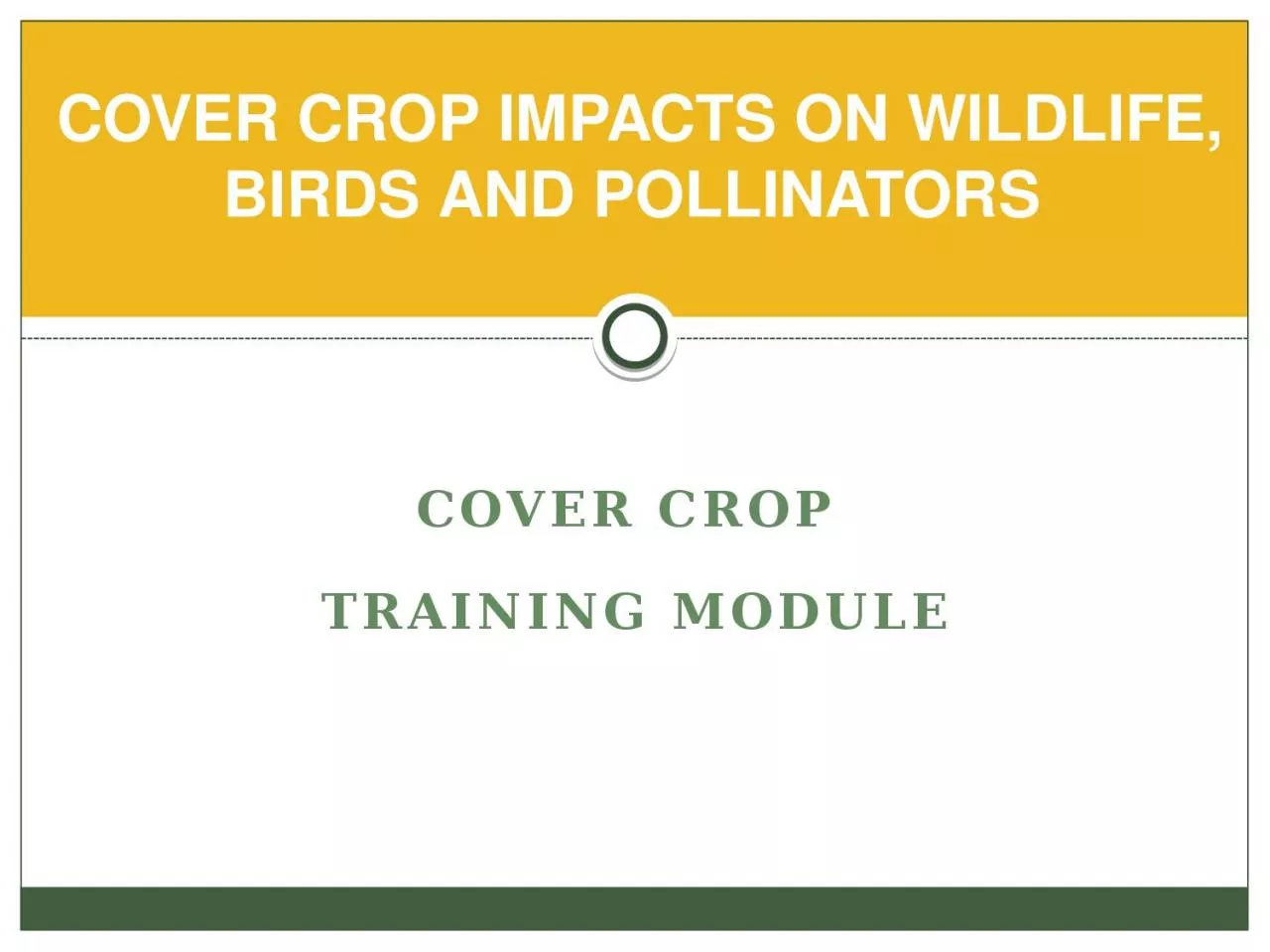

COVER CROP IMPACTS ON WILDLIFE BIRDS AND POLLINATORS Cover crops impact a wide range of wildlife birds and invertebrates Mammals Songbirds raptors and game birds Herpetofauna reptiles and amphibians ID: 1026394
Download Presentation The PPT/PDF document "Cover crop training module" is the property of its rightful owner. Permission is granted to download and print the materials on this web site for personal, non-commercial use only, and to display it on your personal computer provided you do not modify the materials and that you retain all copyright notices contained in the materials. By downloading content from our website, you accept the terms of this agreement.
1. Cover crop training moduleCOVER CROP IMPACTS ON WILDLIFE, BIRDS AND POLLINATORS
2. Cover crops impact a wide range of wildlife, birds and invertebratesMammalsSongbirds, raptors, and game birdsHerpetofauna (reptiles and amphibians)Pollinators and beneficial insectsWhat’s good for invertebrates is good for everything else – key part of the food chainMatthew WycheMDCMDC
3. Cover crops impact invertebratesFoodSupports earthworms with detritus and by protecting soil (and the earthworms are a food source for some birds and mammals)Decomposing invertebrates enrich the soilHabitatGround cover is critical for overwintering insectsSjoerd Duiker
4. Invertebrates are a key part of the food chainInvertebrates: insects, spiders, mites, earthworms, snails, etc. Beneficial insects: insects that provide some service to people (pollinators, predators/parasitoids, nutrient cyclers)Natural enemies: invertebrate predators and parasitoids that help control pest insectsSpiders, insect predators, millipedes, etc.The base of the food chain: invertebrates feed birds, reptiles, bats, and other mammals
5. Invertebrate impactsFlowering cover crops provide nectar and pollen to pollinators and natural enemiesCover crop supports diverse plant-feeding insects that support predators until cash crop plantingSpraying insecticide eliminates predators Ansel Oommen, Bugwood.orgRyan Stocwell
6. Other invertebrate impactsNectar and pollen year for late-emerging insectsMaintain natural enemy populations Reproductive habitatInsects that oviposit in plantsNRCS MontantaRob Myers
7. Cover crops as habitatCover crops can help wildlife bridge the green gap between harvest and planting in Midwestern corn-soy rotationsHuge conservation potential given the percentage of land in row-crop agriculture, over 250 million acresRob MyersRob MyersRob Myers
8. Bird impacts of cover crops: winterFood and protective coverResident birds benefitQuailTurkeyPheasantSongbirdsMDC
9. Birds: Winter impactsFood and cover for migratory birdsWaterfowlSongbirdsRyan Stockwell
10. Birds: spring impactsNesting habitatProtection from predatorsCould save grassland species like dicksissel and eastern meadowlarkFoodInsects very important for bird diets in the springQuail may benefit from cover crops both from more insects to eat as well as cover/habitatU of Missouri ExtensionNRCSNRCS
11. Birds:Summer impactsPotentially the greatest benefits for grassland birds come in the summerBrood-rearing coverLate nestersGold-finchesFoodSeedsInsects Stocking up for fall migrationsU of Missouri Extension
12. Mammals:Winter impactsForageFood plot mixes often contain the same plant species as cover crop mixesFood and cover for voles, rabbits and furbearers
13. Small mammals
14. Mammals: Springand summer impactsDeerFawning and bedding habitatPotential for diverse dietVoles and rabbits have potential to reach damaging populationsU of Missouri Extension
15. HerpetofaunaUnderstudiedCover crops probably offer overwintering habitat and protection from predatorsCover cropped areas can provide protection for moving between breeding ponds or other breeding locationsRob Myers
16. PredatorsRaptorsMore food from small mammals and herpetilesHunting may be more difficult in tall cover crop but also more game to huntRaptors benefit from places to perch
17. PredatorsBenefit from cover and greater prey populationsRaptors, coyotes foxes, and other predators consume potential crop pests
18. Cover crops as habitatCover crops can help wildlife bridge the green gap between harvest and planting in Midwestern corn-soy rotationsHuge conservation potential given the percentage of land in row-crop agricultureRob Myers
19. Managing cover crops for wildlife – try more than just cereal ryePlant mixesInclude flowering species that bloom at different timesLet cover crops grow through peak bloomSupports insects (particularly pollinators and natural enemies)Nesting birds switching to an insect-based diet
20. Combining cover crops with other conservation practices: No-till impactsInvertebratesProtects overwintering invertebrates from fall tillageAllows natural enemies to better move from cover crops to cash crops in the springBirdsProtects bird nests. Tillage destroys 100% of nests, no-till planting only 70-90%Reptiles, amphibians, and mammalsProtects them from being killed by tillageMaintains insect food sourcePredatorsTillage eliminates most of prey base during critical breeding periods in the spring
21. Cover crops combined with contour buffer stripsPhoto credit: Edwin Remsburg
22. Other conservation practicesPerennial wildflower stripsWindbreaksBeetle banksRiparian buffersEdge featheringNRCS and state funding options are availableRob Myers
23. Cover crops can be a key part of a diversified farm landscapeCover crops in row crop fields can help tie together natural habitat areas that would otherwise be too small to sustain certain populations of animals, birds, and invertebratesAlso, many indirect but still important benefits to wildlife like better water quality, reduced impacts from ag chemicals, etc.SARE